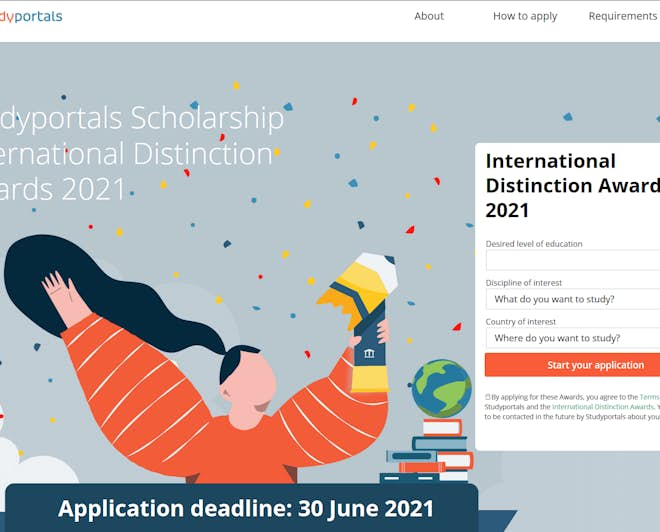Planning to study abroad? Then you already know that tuition fees and living costs can quickly add up to a large budget for your education. Luckily, scholarships provide the essential financial support that so many students need.
Find scholarships to study abroad
In this article, you’ll find answers to the following questions:
- What is a scholarship, and how is it different from grants and student loans?
- Who can apply for a scholarship?
- How can you apply for a scholarship?
- How to find study abroad scholarships?
- What types of scholarships are out there?
Before diving right in, here are a few universities we recommend for studies abroad:
- University of California, Berkeley (UCB), the US
- University of Toronto, Canada
- Imperial College London, the UK
- IU International University of Applied Sciences, Germany
- Université de Lyon, France
- EU Business School, Spain
- University of Canberra, Australia
What is a scholarship?
According to the Cambridge dictionary, a scholarship is “an amount of money given by a school, college, university, or other organisation to pay for the studies of a person with great ability but little money.” I will add that some scholarships are more flexible, allowing all students to apply regardless of their academic abilities or finances.
Differences between scholarships and grants
Both scholarships and grants are types of gift aid, which means students do not need to pay the money back. But grants are usually need-based, and often go to young people who cannot afford the costs of their studies. In contrast, most scholarships are awarded based on academic, athletic, or artistic abilities.
Differences between scholarships and student loans
Unlike scholarships, student loans are a form of financial aid that needs to be paid back, sometimes with interest. Student loans can be both a blessing and a curse in disguise. In the US, for example, student loan debt has reached an eye-watering 1.5 trillion USD in 2020.
Who can apply for scholarships?
Anyone who meets the application requirements can apply. Yes, it’s a ‘Captain Obvious’ answer, but different types of scholarships target different students. Always check if you can apply, if the scholarship application deadlines are up-to-date, and if the scholarship is open to national students, international students, or both.
These are some of the most common application requirements for scholarships:
- registration or application form
- letter of motivation or personal essay
- letter of recommendation
- letter of acceptance from an academic institution
- proof of low income, official financial statements
- proof of extraordinary academic or athletic achievement
How can you apply for a scholarship?
Once you’ve found a study abroad scholarship for which you can apply, start preparing your documents. A typical application process looks like this:
- Register for the scholarship, usually by completing an online application form.
- Check your inbox to make sure you’ve received the confirmation email.
- Write a personal statement or essay. There are enough models on the internet but remember to be original and impress through your unique experiences and ideas.
- Get official proof of your academic, athletic, or artistic achievements. Translate the documents if necessary — it usually is.
- Or get official proof of your low income or nationality (for region-based scholarships). Again, a translation might be necessary.
- Proofread all documents for errors and send them to the scholarship provider.
- Submit the acceptance letter from the university (or an official document from the university proving you’ve been accepted). You won’t receive the scholarship without confirming that you will actually begin studies.
- Wait for the results. If selected, congratulations, you’re a winner! Go ahead and throw a party but don’t spend all your scholarship money on it. Just kidding; the university or college usually receive the money directly to cover your tuition (or a part of it).

How to find study abroad scholarships?
The official websites of your favourite universities are the best place to start searching for a scholarship. If you don’t find anything relevant, contact a representative via email or chat and see if they can help.
The next step is to look for financial aid in other places on the internet. But it’s not always easy to find reliable information and not all websites have up-to-date content. Here are a few resources that can help you find the right scholarship programme:
- Scholarshipportal.com – our own database where we list over 5,000 scholarship opportunities
- Scholarships for Development – website providing financial aid programmes especially focused on students from developing countries
- Official EU scholarship page – list of scholarships available for studies in Europe
- Scholarships.com – database with over 3.5 million scholarships and grants
The official study abroad pages of individual countries also offer information about scholarships:
- official info about scholarships in Austria
- official info about scholarships in Denmark
- official info about scholarships in France
- official info about scholarships in Germany
- official info about scholarships in Sweden
- official info about scholarships in the Netherlands
- official info about scholarships in the UK
What types of scholarships are out there?
The following are the most common types of scholarships you can apply for your studies abroad:
- scholarships for excellent academic results (also called merit scholarships)
- scholarships for research, artistic, or athletic achievements
- scholarships for students with low incomes
- scholarships for under-represented groups (e.g. women, Hispanic and African-American students, citizens from developing countries)
- scholarships for all international students (e.g. the Studyportals Scholarship: International Distinction Awards)
Scholarships for excellent academic results
You need to be a top student to apply for this type of scholarships. Universities and colleges are the most common organisations offering scholarships for academic excellence, but they aren’t the only ones. To find out if a university offers this type of financial aid, check out the ‘costs and funding’ page on the official university website.
Scholarships for research, artistic, or athletic achievements
If you’re into research, sports, or arts, then this scholarship category is for you. Athletic excellence scholarships are especially popular in the US, but you can find them in other countries as well. To receive financial aid, you need to showcase your skills. This might involve impressing scouts, showing research skills beyond your age, or creating a work of art that could easily impress critics.
Scholarships for students with low incomes
This type of scholarships is very similar to grants. The aim is to support students who want to study but cannot afford to pay the full tuition fees or living costs. Universities and other organisations make an excellent investment with need-based scholarships because future graduates often give back to their community and try to help others who face the same struggles.
Scholarships for underrepresented groups
The goal is to support and encourage individuals from underrepresented groups to pursue education without worrying about costs. Here are a few examples:
- women
- Native Americans
- African-Americans
- Hispanic-Latino
- students from developing countries
Scholarships for all international students
Not all scholarships target this or that group of students. Some private institutions or non-governmental organisations (NGOs) simply want to contribute to higher education and allow any international students to apply for their scholarship. These students still have to meet the requirements, but those are very general and broad, not focused on a specific region, minority, or ability.






